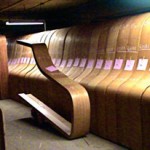Bending Rims Since the 1870's
December 14, 2012 •Chuck Johnson
Steinway & Sons pianos have long been considered the best pianos in the world, and while many people know this, not many people know why. Though every aspect of Steinway’s creation process contributes to the magnificence of its pianos, there are a few key features that stand out. In the third part of this series, this we will talk about the rim, and rim bending process and it's importance to the Steinway piano.
Building a Sound Foundation
 The rim of a piano is one of its most easily identifiable parts. It is what gives the grand piano its iconic shape, it’s what everyone sees when they look at a piano, and it is the foundation upon which the rest of the piano is built.
The rim of a piano is one of its most easily identifiable parts. It is what gives the grand piano its iconic shape, it’s what everyone sees when they look at a piano, and it is the foundation upon which the rest of the piano is built.
Steinway & Sons has always understood that in order to create a quality instrument, they must create a strong and resilient foundation. It is with this idea that they developed their unique rim-bending process in the 1870’s, and they continue to use that same process to this day. To understand the process, let’s look at the parts.
Strength in Numbers
All Steinway & Sons pianos have rims that are constructed of multiple laminations of plain-sawed, hard rock maple. Maple is a wood that can withstand an incredible amount of pressure from the strings, provide a solid and sturdy support for the keyboard and action, as well as accept a finish to become not only an instrument in construction, but a beautiful piece of furniture.
Many wonder why laminations are used as opposed to a solid piece of wood. For one, a solid, knot-free piece of hard-rock maple is virtually impossible to come by. More importantly however, is that the multiple boards, the glue, and the balanced stresses of the grain make up a rim that is stronger than the sum of the parts.
Inner Rim; Meet Outer Rim
There are two rims to a piano: the inner rim, and the outer rim. The inner rim is the base and support for the soundboard, and the outer rim is
Steinway has a different approach to the rim-bending process.
Bending Rims Since the 1870’s
Instead of bending the inner and outer rim separately, Steinway bends both rims together in one unified process. Doing this not only creates a physically stronger foundation, but a sonically stronger foundation as well. The structural integrity of the Steinway rim means that no vibration is lost, therefore maximum power and sound is achieved.

Let the Wood Rest
The rim is left on the mold for twenty-four hours before it’s dated, marked, and moved to a temperature and humidity controlled chamber where it rests for at least ten weeks. This rest period is paramount, as the wood needs to accept its new shape, as well as return to its optimal moisture content. This process is a hallmark of Steinway pianos, as it is one that requires a level of mastery that can’t be found elsewhere and results in excellence. It is also a more time consuming, and ultimately, expensive procedure. However, it is the superior way of creating a piano rim and Steinway has practiced this method for well over 100 years.
This process is a hallmark of Steinway pianos, as it is one that requires a level of mastery that can’t be found elsewhere and results in excellence. It is also a more time consuming, and ultimately, expensive procedure. However, it is the superior way of creating a piano rim and Steinway has practiced this method for well over 100 years.
Steinway & Sons pianos hold over a century’s worth of innovations, from the rim-bending process to the Accelerated Action, and they continue to “build the finest possible piano at the lowest possible price.”
Featured Articles
Categories
- Beginner Pianos (23)
- Boston Pianos (15)
- Comparisons (30)
- Designer and Specialty Pianos (8)
- Essex Pianos (10)
- Events (11)
- Featured (24)
- Institutional (3)
- Joy of Piano (15)
- Learning About Pianos (69)
- News (35)
- Pricing and Cost (19)
- Resource Center (122)
- Roland Pianos (6)
- Spirio (15)
- Steinway Pianos (70)
- Student (14)
- Teacher (13)
- Used Pianos (20)
- Videos (19)


